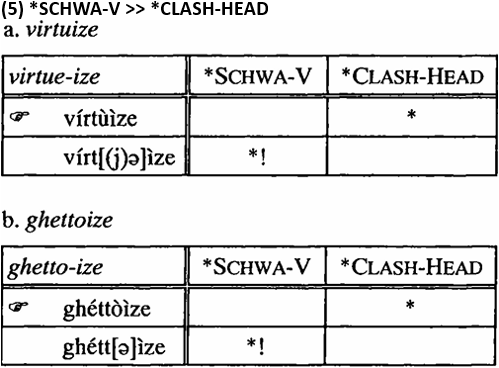
Non-uniform preservation of secondary stress
 المؤلف:
Ingo Plag
المؤلف:
Ingo Plag
 المصدر:
Morphological Productivity
المصدر:
Morphological Productivity
 الجزء والصفحة:
P179-C6
الجزء والصفحة:
P179-C6
 2025-02-05
2025-02-05
 627
627
Non-uniform preservation of secondary stress
There is yet another class of V-final, non-dactylic derivatives that need to be discussed, namely those with bases ending in a secondarily stressed vowel such as ghéttòìze or ràdiòìze. The base-final vowels in such derivatives survive intact, i.e. they are neither deleted nor destressed. However, consonant-final bases which end in a secondarily stressed syllable (e.g. ànòde) exhibit destressing of their final syllable under -ize attachment (cf. án[s]dìze). How can this non-uniformity effect be accounted for?
With disyllabic bases such as ghéttòìze, * CLASH-HEAD already rules out truncation of the final vowel (cf. *ghéttìze), but this does not explain why base words such as ràdio are not truncated. In their case, truncation would not lead to a *CLASH-HEAD violation, but to a better satisfaction of R ALIGN-HEAD. These facts suggest that a constraint against the deletion of stressed vowels must be ranked higher than R-ALIGN-HEAD. Assuming that faithfulness constraints may be specified for privileged prosodic positions such as onsets, root-initial positions or stressed syllables (Beckman 1998), I propose the constraint in (1), which prohibits the deletion of stressed vowels:
(1) 
This constraint must be ranked above R-ALIGN-HEAD, as shown in the following tableau.

The truncated candidate (rádi)(ìze) better satisfies R-ALIGN-HEAD but violates the higher ranked MAX-σ̒-V.
With disyllabic bases such as géttòìze the question arises why the final vowel is not destressed as it can be observed with consonant-final base words that have a secondarily stressed ultima (cf. ànòde – án[p]dìze). Informally speaking, the affixation of -ize to such base words gives the opportunity to avoid the stress clash present in the underived output form (ànòde). In other words, a * CLASH-HEAD violation is avoided on the cost of some other constraint which demands that stressed syllables in the base form be stressed in the derived form (this is again an output-output constraint):
(3) STRESS-IDENT "
"stressed elements in the base form must be stressed in the derived form"1
This yields the tableau in (4):

Note that MAX-σ̒-V is not violated by the optimal candidate because there is still some correspondent in the output.
Returning to base forms such as radio, ghetto or virtue, destressing would involve a *SCHWA-V violation, which is obviously not desired, as the final vowel regularly remains stressed in the derivatives. Thus, a stress clash is preferred to schwa-vowel adjacency. These facts suggest the ranking as exemplified in (5):

The tableaux in (4) and (5) capture the generalization that secondarily stressed vowels are reduced, if this does not lead to a *SCHWA-V violation.
However, a violation of *SCHWA-V could also be avoided by the insertion of a glottal stop, as in ghétt[əʔ]ìze. As we saw above, DEP is ranked lower on the hierarchy, which is corroborated by the fact that glide insertion is otherwise tolerated (cf. ràdiò[w]ìze, vìrtù[w]ìze). One possibility is to rank DEP above * CLASH-HEAD, this is not a viable solution. The crucial observation concerning the pertinent data is that STRESS-IDENT may be violated only if it is not accompanied by a DEP violation. This is the kind of situation for which Smolensky (1993, 1995, 1997) has introduced the idea of local conjunction of constraints. According to this proposal, two constraints may form a composite constraint which is violated, if and only if each of the conjoined constraints is violated in some given domain. The conjoined constraint only has tangible effects if some other constraint(s) is/are ranked between the conjoined constraint and the individual constraints that together make up the conjoined constraint (see also Ito and Mester (1998) for discussion).
In our case the conjoined constraint STRESS-IDENT & DEP is ranked above *CLASH-HEAD, with each of the individual constraints STRESS-IDENT and DEP being ranked below * CLASH-HEAD. Now the correct optimal candidate emerges:

There are three derivatives in the neologism corpus that do not behave as demanded by the proposed constraints, Locarnize (< Locàrnò), fìnìtìze (< finite) and sátellìze (< sátellìté). The two latter forms should exhibit de stressing of the base-final syllable (i.e. !fín[ɪ]tìze, !sátell[ɪ]tìze) instead of stress preservation and truncation, respectively. They must be regarded as idiosyncratic formations. With Locárnìze, the base-final vowel of Locàrnò is deleted inspite of the fact that this leads to a violation of both MAX-σ̒-V and * CLASH-HEAD. In other words, this is again an idiosyncratic form which the proposed model cannot account for, and which illustrates the fact that even newly created forms may occasionally violate well formedness conditions on complex words.
 الاكثر قراءة في Morphology
الاكثر قراءة في Morphology
 اخر الاخبار
اخر الاخبار
اخبار العتبة العباسية المقدسة


